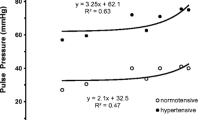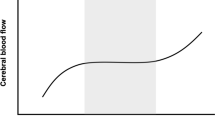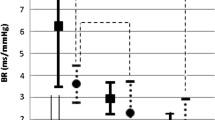Abstract
Previous studies have found that Alzheimer’s disease (AD) impairs cerebral vascular function, even at early stages of the disease. This offers the prospect of a useful diagnostic method for AD, if cerebral vascular dysfunction can be quantified reliably within practical clinical constraints. We present a recently developed methodology that utilizes a data-based dynamic nonlinear closed-loop model of cerebral hemodynamics to compute “physiomarkers” quantifying the state of cerebral flow autoregulation to pressure-changes (CA) and cerebral CO2 vasomotor reactivity (CVMR) in each subject. This model is estimated from beat-to-beat measurements of mean arterial blood pressure, mean cerebral blood flow velocity and end-tidal CO2, which can be made reliably and non-invasively under resting conditions. This model may also take an open-loop form and comparisons are made with the closed-loop counterpart. The proposed model-based physiomarkers take the form of two indices that quantify the gain of the CA and CVMR processes in each subject. It was found in an initial set of clinical data that the CVMR index delineates AD patients from control subjects and, therefore, may prove useful in the improved diagnosis of early-stage AD.












Similar content being viewed by others
References
Aaslid, R., K. F. Lindegaard, W. Sorteberg, and H. Nornes. Cerebral autoregulation dynamics in humans. Stroke 20:45–52, 1989.
Bell, R. D., and B. V. Zlokovic. Neurovascular mechanisms and blood-brain barrier disorder in Alzheimer’s disease. Acta Neuropathol. 118(1):103–113, 2009.
Bellapart, J., and J. F. Fraser. Transcranial Doppler assessment of cerebral autoregulation. Ultrasound Med. Biol. 2009. doi:10.1016/j.ultrasmedbio.
Bowler, J. V. Acetylcholinesterase inhibitors for vascular dementia and Alzheimer’s disease combined with cerebrovascular disease. Stroke 34:584–586, 2003.
Claassen, J. A., R. Diaz-Arrastia, K. Martin-Cook, B. D. Levine, and R. Zhang. Altered cerebral hemodynamics in early Alzheimer disease: a pilot study using transcranial Doppler. J. Alzheimers Dis. 17(3):621–629, 2009.
Claassen, J. A., and R. Zhang. Cerebral autoregulation in Alzheimer’s disease. J. Cereb. Blood Flow Metab. 31(7):1572–1577, 2011.
Cupini, L. M., M. Diomedi, F. Placidi, M. Silvestrini, and P. Giacomini. Cerebrovascular reactivity and subcortical infarctions. Arch. Neurol. 58:577–581, 2001.
Czosnyka, M., K. Brady, M. Reinhard, P. Smielewski, and L. Steiner. Monitoring of cerebrovascular autoregulation: facts, myths and missing links. Neurocrit. Care 10:373–386, 2009.
Czosnyka, M., S. Piechnik, H. Richards, P. Kirkpatrick, P. Smielewski, and J. Pickard. Contribution of mathematical modeling to the interpretation of bedside tests of cerebrovascular autoregulation. J. Neurol. Neurosurg. Psychiatry 63:721–731, 1997.
de la Torre, J. C. Alzheimer disease as a vascular disorder. Nosological evidence. Stroke 33:1152–1162, 2002.
Giller, C. A. The frequency-dependent behavior of cerebral autoregulation. Neurosurgery 27:362–368, 1990.
Giller, C. A., and M. Mueller. Linearity and nonlinearity in cerebral hemodynamics. Med. Eng. Phys. 25:633–646, 2003.
Gorelick, P. B. Risk factors for vascular dementia and Alzheimer disease. Stroke 35:2620–2622, 2004.
Hachinski, V., and C. Iadecola. Vascular cognitive impairment: introduction. Stroke 35:2615, 2004.
Hanon, O., M. L. Seux, H. Lenoir, A. S. Rigaud, and F. Forette. Prevention of dementia and cerebroprotection with antihypertensive drugs. Curr. Hypertens. Rep. 6:201–207, 2004.
Hardy, J. The amyloid hypothesis for Alzheimer’s disease: a critical reappraisal. J. Neurochem. 110:1129–1134, 2009.
Iadecola, C. Cerebrovascular effects of amyloid-beta peptides: mechanisms and implications for Alzheimer’s dementia. Cell. Mol. Neurobiol. 23:681–689, 2003.
Iadecola, C., and P. B. Gorelick. Converging pathogenic mechanisms in vascular and neurodegenerative dementia. Stroke 34:335–337, 2003.
Kalaria, R. N. Small vessel disease and Alzheimer’s dementia: pathological considerations. Cerebrovasc. Dis. 13:48–52, 2002.
Kiyoshi, N., K. Kazama, L. Younkin, S. G. Younkin, G. A. Carlson, and C. Iadecola. Cerebrovascular autoregulation is profoundly impaired in mice overexpressing amyloid precursor protein. Am. J. Physiol. Heart Circ. Physiol. 283:H315–H323, 2002.
Langa, K. M., N. L. Foster, and E. B. Larson. Mixed dementia: emerging concepts and therapeutic implications. J. Am. Med. Assoc. 292:2901–2908, 2004.
Maeda, H., M. Matsumoto, N. Handa, H. Hougaku, S. Ogawa, T. Itoh, Y. Tsukamoto, and T. Kamada. Reactivity of cerebral blood flow to carbon dioxide in various types of ischemic cerebrovascular disease: evaluation by the transcranial Doppler method. Stroke 24:670–675, 1993.
Markus, H. S., and M. J. Harrison. Estimation of cerebrovascular reactivity using transcranial Doppler, including the use of breath-holding as the vasodilatory stimulus. Stroke 23:668–673, 1992.
Marmarelis, V. Z. Identification of nonlinear biological systems using Laguerre expansions of kernels. Ann. Biomed. Eng. 21:573–589, 1993.
Marmarelis, V. Z. Modeling methodology for nonlinear physiological systems. Ann. Biomed. Eng. 25:239–251, 1997.
Marmarelis, P. Z. and V. Z. Marmarelis. Analysis of Physiological Systems: The White-Noise Approach. Plenum, New York, 1978 (Russian translation, Mir Press, Moscow, 1981; Chinese translation, Academy of Sciences Press, Beijing, 1990).
Marmarelis, V. Z., D. C. Shin, and R. Zhang. Linear and nonlinear modeling of cerebral flow autoregulation using Principal Dynamic Modes. Open Biomed. Eng. J. 6:42–55, 2012.
Marmarelis, V. Z., D. C. Shin, M. E. Orme, and R. Zhang. Closed-loop dynamic modeling of cerebral hemodynamics. Ann. Biomed. Eng. (in press). doi:10.1007/s10439-012-0736-8.
Marmarelis, V. Z. Nonlinear Dynamic Modeling of Physiological Systems. Wiley-Interscience, 2004.
Mitsis, G. D., M. J. Poulin, P. A. Robbins, and V. Z. Marmarelis. Nonlinear modeling of the dynamic effects of arterial pressure and CO2 variations on cerebral blood flow in healthy humans. IEEE Trans. Biomed. Eng. 51:1932–1943, 2004.
Mitsis, G. D., R. Zhang, B. D. Levine, and V. Z. Marmarelis. Modeling of nonlinear physiological systems with fast and slow dynamics II: application to cerebral autoregulation. Ann. Biomed. Eng. 30:555–565, 2002.
Mitsis, G. D., R. Zhang, B. D. Levine, and V. Z. Marmarelis. Cerebral hemodynamics during orthostatic stress assessed by nonlinear modeling. J. Appl. Physiol. 101:354–366, 2006.
Mitsis, G. D., R. Zhang, B. D. Levine, E. Tzanalaridou, D. G. Katritsis, and V. Z. Marmarelis. Nonlinear analysis of autonomic control of cerebral hemodynamics. IEEE Eng. Med. Biol. 28:54–62, 2009.
Murray, I. V. J., J. F. Proza, F. Sohrabji, and J. M. Lawler. Vascular and metabolic dysfunction in Alzheimer’s disease: a review. Exp. Biol. Med. 236(7):772–782, 2011.
Nicolakakis, N., and E. Hamel. Neurovascular function in Alzheimer’s disease patients and experimental models. J. Cereb. Blood Flow Metab. 31(6):1354–1370, 2011.
Panerai, R. B. Cerebral autoregulation: from models to clinical applications. Cardiovasc. Eng. 8:42–59, 2008.
Panerai, R. B. Transcranial Doppler for evaluation of cerebral autoregulation. Clin. Auton. Res. 2009. doi:10.1007/s10286-009-0011-8.
Panerai, R. B., S. L. Dawson, and J. F. Potter. Linear and nonlinear analysis of human dynamic cerebral autoregulation. Am. J. Physiol. 277:H1089–H1099, 1999.
Panerai, R. B., D. M. Simpson, S. T. Deverson, P. Mahony, P. Hayes, and D. H. Evans. Multivariate dynamic analysis of cerebral blood flow regulation in humans. IEEE Trans. Biomed. Eng. 47:419–423, 2000.
Paulson, O. B., S. Strandgaard, and L. Edvinsson. Cerebral autoregulation. Cerebrovasc. Brain Metab. Rev. 2:161–192, 1990.
Roher, A. E., Y. M. Kuo, C. Esh, C. Knebel, N. Weiss, W. Kalbach, D. C. Luehrs, J. L. Childress, T. G. Beach, R. O. Weller, and T. A. Kokjohn. Cortical and leptomeningeal cerebrovascular amyloid and white matter pathology in Alzheimer’s disease. Mol. Med. 9:112–122, 2003.
Schneider, J. A., R. S. Wilson, J. L. Bienias, D. A. Evans, and D. A. Bennett. Cerebral infarctions and the likelihood of dementia from Alzheimer disease pathology. Neurology 62:1148–1155, 2004.
Sellke, F. W., S. Seshadri, H. C. Chui, R. T. Higashida, R. Lindquist, P. M. Nilsson, G. C. Roman, R. C. Petersen, J. A. Schneider, C. Tzourio, D. K. Arnett, D. Bennett, C. Iadecola, L. J. Launer, S. Laurent, O. L. Lopez, D. Nyenhuis, P. B. Gorelick, A. Scuteri, S. E. Black, C. DeCarli, and S. M. Greenberg. Vascular contributions to cognitive impairment and dementia: a statement for healthcare professionals from the AHA/ASA. Stroke 42(9):2672–2713, 2011.
Silvestrini, M., P. Pasqualetti, R. Baruffaldi, M. Bartolini, Y. Handouk, M. Matteis, F. Moffa, L. Provinciali, and F. Vernieri. Cerebrovascular reactivity and cognitive decline in patients with Alzheimer’s disease. Stroke 37:1010–1015, 2006.
Smith, E. E., and S. M. Greenberg. Amyloid-beta, blood vessels and brain function. Stroke 40(7):2601–2606, 2009.
Tantucci, C., P. Bottini, C. Fiorani, M. L. Dottorini, F. Santeusanio, L. Provinciali, C. A. Sorbini, and G. Casucci. Cerebrovascular reactivity and hypercapnic respiratory drive in diabetic autonomic neuropathy. J. Appl. Physiol. 90:889–896, 2001.
Tong, X. K., N. Nicolakakis, A. Kocharyan, and E. Hamel. Vascular remodeling versus amyloid beta-induced oxidative stress in the cerebrovascular dysfunctions associated with Alzheimer’s disease. J. Neurosci. 25(48):11165–11174, 2005.
van Beek, A. H., J. A. Claassen, M. G. Rikkert, and R. W. Jansen. Cerebral autoregulation: overview of current concepts and methodology with special focus on the elderly. J. Cereb. Blood Flow Metab. 28:1071–1085, 2008.
van Beek, A. H., J. Lagro, M. G. Olde-Rikkert, R. Zhang, and J. A. Claassen. Oscillations in cerebral blood flow and cortical oxygenation in Alzheimer’s disease. Neurobiol. Aging 33(2):428.e21–428.e31, 2012.
Yaffe, K., E. Barrett-Connor, F. Lin, and D. Grady. Serum lipoprotein levels, statin use, and cognitive function in older women. Arch. Neurol. 59:378–384, 2002.
Zhang, R., J. H. Zuckerman, C. A. Giller, and B. D. Levine. Transfer function analysis of dynamic cerebral autoregulation in humans. Am. J. Physiol. 274:233–241, 1998.
Zhang, R., J. H. Zuckerman, K. Iwasaki, T. E. Wilson, C. G. Crandall, and B. D. Levine. Autonomic neural control of dynamic cerebral autoregulation in humans. Circulation 106:1814–1820, 2002.
Acknowledgments
This work was supported in part by the Biomedical Simulations Resource at the University of Southern California under NIH/NIBIB grant P41-EB001978 and NIA R01AG033106-01 grant to the UT-Southwestern Medical Center.
Author information
Authors and Affiliations
Corresponding author
Additional information
Associate Editor Aleksander S. Popel oversaw the review of this article.
Appendices
Appendix I: Basics of Volterra and Open-Loop PDM-based Modeling
The general nonparametric Volterra model is applicable to all finite-memory dynamic nonlinear systems, which covers almost all physiological systems (with the exception of chaotic systems or non-dissipating oscillators).26,29 In the proposed methodology, the modeling task commences with the estimation of a second order Volterra model of the two-input CHAR system using Laguerre expansions of the kernels24:
where p(t) denotes the MABP input, x(t) denotes the ETCO2 input, y(t) denotes the mean cerebral blood flow velocity (MCBFV) output and ε(t) denotes possible measurement or modeling errors. The dynamic characteristics of this system/model are described by the kernels: k p , k x , k pp , k xx , k px , which are estimated using given input–output data: p(t), x(t), and y(t), by means of Laguerre expansions and least-squares fitting as described below. Consider, for instance, the Laguerre expansion of the rth order kernels corresponding to two inputs:
where {b j (τ)} denotes the orthogonal Laguerre function basis. Then, we have the following input–output relation which involves linearly the Laguerre expansion coefficients {a r } and {c r }:
where the signals v j (t) and z j (t) are the convolutions of the Laguerre basis function b j with the respective input. Note that in the model equation (A3) the cross-kernel contribution has been suppressed in the interest of simplifying the model expression. The cross-kernel effects are accounted by expansion terms involving products of the signals v j (t) and z j (t). The fact that the Laguerre expansion coefficients enter linearly in the nonlinear input–output model of Eq. (A3) allows their estimation via least-squares fitting (a simple and robust numerical procedure). Following estimation of the Laguerre expansion coefficients, we can construct the Volterra kernel estimates using Eq. (A2) and compute the model prediction for any given input using Eq. (A1) or (A3).
Although the Laguerre expansion technique brings considerable model estimation efficiencies, it does not remove the “curse of dimensionality” associated with the multi-dimensional structure of high-order kernels. In order to overcome this practical limitation, we have introduced the concept of Principal Dynamic Modes (PDM), which aims at identifying an efficient “basis” of functions (distinct and characteristic for each system) that are capable of representing adequately the system dynamics (i.e., provide satisfactory expansions of the kernels). The computation of the PDMs for each input is based on Singular Value Decomposition (SVD) of a rectangular matrix composed of the first order kernel estimate (as a column vector) and the second order self-kernel estimate (as a block matrix) weighted by the standard deviation of the respective input.
The resulting PDMs form a filter-bank that receives the respective input signal and generates (via convolution) signals that are subsequently transformed by the “Associated Nonlinear Function” (ANFs), which represents the nonlinear characteristics of the system for the respective PDM dynamics, to form additively the system output, as depicted schematically in Fig. 2. Thus, the PDM-based model separates the dynamics (PDMs) from the nonlinearities (ANFs). Since the “separability” of the system nonlinearity cannot be generally assumed, we include “cross-terms” in the PDM-based model that are properly selected on the basis of a statistical significance test on the computed correlation coefficient between each cross-term (i.e., the pair product of PDM outputs) and the output signal, using the w-statistic.26 Three PDMs for each input and up to 6 cross-terms were found to be adequate in this application.
The structure of the PDM-based model of the two-input/one-output CA-CVMR system is shown in Fig. 2. The employed “global” PDMs represent a common “functional basis” for efficient representation of all kernels of the CHAR system for all subjects. These “global” PDMs are obtained via SVD of a rectangular matrix containing the PDMs of all subjects in a selected reference group (16 control subjects in this case). Although the global PDMs are common for all subjects, the estimated ANF for each global PDM and the coefficients of the cross-terms are subject-specific and can be used to characterize uniquely the CHAR process for each subject. The use of PDMs allows us to write the output Eq. (A3) as:
where {u h } and {w m } are the PDM outputs (i.e., convolutions of the input with the respective PDM) for the MABP and ETCO2 inputs, respectively, and {f h } and {f m } are the ANFs associated with each PDM. The ANFs are typically polynomials (cubic in this application). The “Cross-Terms” in Eq. (A4) are pair products of {u h } and {w m } that have significant correlation with the output. The coefficients of the selected Cross-Terms are estimated, along with c 0 and the coefficients of the (cubic) ANFs via least-squares regression of Eq. (A4).
Appendix II: Closed-Loop PDM-based Modeling
The closed-loop analysis requires the estimation of two open-loop PDM-based models A and B, following the approach described in Appendix I, which are placed in the configuration of Fig. 3. The disturbance signals F d (t) and P d (t) are computed in each case as the model-prediction residuals and they are viewed as the physiological “disturbances” or “drives” of the closed-loop system. In accordance with Fig. 3, we have two equivalent closed-loop equations:
which are nonlinear stochastic integral equations, since we have for each open-loop model:
where the signals u(t) are convolution integrals of the input signals with the PDMs, the functions f [·] are polynomials (cubic in this case), and F 0, P 0 are the baseline values of MABP and MCBFV respectively (i.e., their values when there are no systemic disturbances). In the case of discretized data, Eqs. (A5) and (A6) are tantamount to nonlinear auto-regressive equations in F(t) or P(t) with stochastic coefficients and an exogenous variable C(t). Simulations with broadband (e.g., band-limited white-noise) systemic disturbances can reveal the spectral characteristics of the closed-loop model for various power levels under isocapnic (C(t) = 0), hypercapnic (C(t) > 0) or hypocapnic (C(t) < 0) conditions.
It is instructive to examine the particular case where the operators A and B are linear, i.e., described by Transfer Functions in the frequency domain. Then, Eq. (A5) yields the following relation in the Laplace domain (i.e., the variables are described by their Laplace Transforms):
where H XY denotes the Transfer Function from input X to output Y. Thus, the dynamics and stability of the closed-loop model are determined by the poles (i.e., the roots) of the expression: (1 − H PF H FP ), i.e., the product H PF H FP in the complex Laplace domain must remain away from 1 in order to maintain stability. The resonances of the closed-loop system are defined by the troughs of the function |1 − H PF H FP | expressed in the Fourier domain.
Rights and permissions
About this article
Cite this article
Marmarelis, V.Z., Shin, D.C., Orme, M.E. et al. Model-based Quantification of Cerebral Hemodynamics as a Physiomarker for Alzheimer’s Disease?. Ann Biomed Eng 41, 2296–2317 (2013). https://doi.org/10.1007/s10439-013-0837-z
Received:
Accepted:
Published:
Issue Date:
DOI: https://doi.org/10.1007/s10439-013-0837-z




